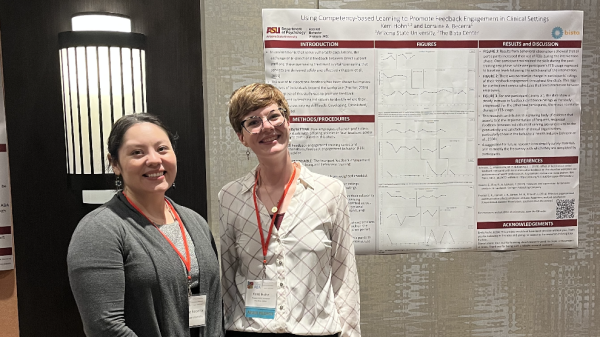ASU initiative teaches middle schoolers the importance of cybersecurity
Open-source curriculum aims to demystify the field and close big jobs gap

Thousands of jobs in cybersecurity are going unfilled and Arizona State University has ramped up an initiative to draw young people to work in this critical field.
ASU’s Cybersecurity Education Consortium is reaching students in elementary and middle school, introducing them to core cybersecurity concepts, generating interest in the topic and working to create a pipeline of local cybersecurity talent, according to Trista Zobitz, project coordinator with the consortium.
“This is a national issue, but it’s also critical to the Phoenix area’s continued emergence as a technology hub,” Zobitz said.
The Cybersecurity Education Consortium is a unit of the Global Security Initiative and is focused on improving the local cybersecurity education ecosystem. It partners with industry, local schools and other units at ASU to deliver cybersecurity content and training.
This past year, the consortium worked with the Center for the Future of Arizona to create a curriculum that teaches middle-school students about protecting computer systems and digital information. In January, a curriculum update will be available, including digital options for schools that are doing remote or hybrid teaching, Zobitz said. The Center for the Future of Arizona has received additional funding that is being used to support building out the content into a virtual platform that will be available next year.
“Cybersecurity is an expanding field that has a growing number of unfilled positions, so we want to get kids interested in the field and moving into the pipeline of degrees and out into the workforce,” she said.
There are expected to be more than 3.5 million unfilled cybersecurity jobs in 2021, according to Cybersecurity Ventures — even as international hacking is a threat to the country’s national security. The average salary for information security analysts in Arizona is about $98,000 a year, according to the U.S. Bureau of Labor Statistics.
ASU offers six undergraduate degrees and one certificate that are pathways to a career in cybersecurity.
The Cybersecurity Middle School Curriculum is targeted for grades six through eight and was funded by a grant from Women and Philanthropy, part of the ASU Foundation.
“We focused on middle school because research shows that it is important to reach students at a younger age, before they pick their academic direction in high school,” Zobitz said.
“We want to give them that exposure and a vision of the field so when they get to high school, they can pick related electives and explore the field further now that they know it exists.”
The Center for the Future of Arizona is a nonprofit that has several education programs. Cindy Erwin, director of college and career pathways at the center, is co-leader of an initiative called Pathway to Prosperity, which has three components: increasing attainment and postsecondary enrollment by launching students into career-connected pathways that allow them to acquire college credits while in high school, creating work-based experiences for teachers and students, and ensuring that all students, as early as middle school, have the opportunity to explore numerous career fields.
“We were thrilled to connect with ASU to build out cybersecurity curriculum to augment high quality STEM career exploration curriculum we are piloting in over 20 classrooms across Arizona,” she said.
The lessons, which are aligned with Arizona state standards, are free to any teacher anywhere.
Zobitz, a former classroom teacher, developed the curriculum with subject matter experts at ASU.
“One thing that was important to me was making sure we were providing teachers with something that met their needs – a resource that teachers can just pick up and implement into their classrooms,” she said.
The modules were designed to be used inside a classroom, with activities such as students building a human “cybersecurity wall” to understand the vulnerabilities if their firewall is not enabled. But with many schools switching to remote or hybrid learning this year, the consortium decided to expand the coursework to provide digital options, Zobitz said.
While any teacher can access the lessons, Pathways to Prosperity provides extra support for teachers in a pilot program in several low-income school districts around the state, Erwin said.
“We talk about the high demand for cybersecurity but at the same time, we work with industry to help expose students who may not see themselves in STEM careers and help them understand that they can do this work,” she said.
Next summer, the consortium, in collaboration with the New College of Interdisciplinary Arts and Sciences, will hold a cybersecurity camp for high school students at the West campus, funded by the National Science Foundation.
A future project for the Cybersecurity Education Consortium project is to create a series of videos to help clarify cybersecurity, so students have a better understanding of the field and the jobs available.
“Students typically have envisioned a guy in a hoodie working in a basement,” Zobitz said.
“The goal of the project is to show a day in the life of cybersecurity professionals, so students can see that they’re regular people who work at desks in offices."
Top image by Pixabay
More Science and technology

Miss Arizona, computer science major wants to inspire children to combine code and creativity
Editor’s note: This story is part of a series of profiles of notable spring 2024 graduates. “It’s bittersweet.” That’s how Tiffany Ticlo describes reaching this milestone. In May, she will graduate…

ASU applied behavior analysis program recognized in Four Corners region
Helping students with learning disabilities succeed in school and modeling effective communication skills are just two examples of how applied behavioral analysis improves lives. Since launching…

Redefining engineering education at West Valley campus
Editor's note: This story originally appeared in the summer 2024 issue of ASU Thrive magazine. What makes the School of Integrated Engineering different from other engineering schools? We listened…